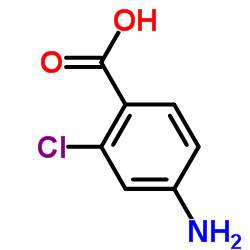4-氨基-2-氯苯甲酸

4-氨基-2-氯苯甲酸结构式

|
常用名 | 4-氨基-2-氯苯甲酸 | 英文名 | 2-Chloro-p-aminobenzoic acid |
|---|---|---|---|---|
| CAS号 | 2457-76-3 | 分子量 | 171.581 | |
| 密度 | 1.5±0.1 g/cm3 | 沸点 | 365.3±27.0 °C at 760 mmHg | |
| 分子式 | C7H6ClNO2 | 熔点 | 211 °C (dec.)(lit.) | |
| MSDS | 中文版 美版 | 闪点 | 174.8±23.7 °C | |
| 符号 |

GHS07 |
信号词 | Warning |
|
Validation of high-performance liquid chromatographic methods on two silica base-deactivated reversed phases for the determination of chloroprocaine and bupivacaine.
J. Pharm. Biomed. Anal. 14(8-10) , 1251-9, (1996) The separation of HPLC of basic drugs on silica-based reversed phases remains a major problem because of the interaction between the residual silanol groups of the silica and the amino function of the drug. This paper describes the validation of HPLC methods ... |
|
|
Intrapartum paracervical block anesthesia with 2-chloroprocaine.
Am. J. Obstet. Gynecol. 146(1) , 16-22, (1983) Most of the reports of fetal bradycardia and acidosis following paracervical block anesthesia have involved the use of amide-linked anesthetics, such as lidocaine and mepivacaine. The purposes of this study were (1) to determine placental transfer of an ester... |
|
|
Comparison of lidocaine and 2-chloroprocaine in paracervical block: clinical effects and drug concentrations in mother and child.
Anesth. Analg. 62(2) , 168-73, (1983) 2-Chloroprocaine (CP) has recently been recommended as a less toxic alternative to amide-type local anesthetics due to its rapid metabolism. A double-blind, randomized study comparing CP to lidocaine when used for paracervical block was carried out. Twenty-ni... |
|
|
Urinary metabolites of chloroprocaine studied by combined gas chromatography--mass spectrometry.
Anesthesiology 54(4) , 329-32, (1981) The purpose of this study was to identify the metabolic pathway of 2-chloro-4-aminobenzoic acid (CABA), a primary metabolite of chloroprocaine. Urine was collected from 4 healthy, pregnant women following the epidural administration of 600 mg chloroprocaine. ... |
|
|
Rapid determination of chloroprocaine and its major metabolite, 2-chloroaminobenzoic acid, in plasma by high-performance liquid chromatography.
J. Chromatogr. B, Biomed. Appl. 675(2) , 336-41, (1996) A sensitive and specific high-performance liquid chromatographic method for determination of the 2-chloroprocaine, local anesthetic of ester type, and its major metabolite 2-chloroaminobenzoic acid, has been developed and validated. A single-step extraction p... |
|
|
Fetal acidosis, 2-chloroprocaine, and epidural anesthesia for cesarean section.
Am. J. Obstet. Gynecol. 151(3) , 322-4, (1985) Amide-linked local anesthetic agents, such as lidocaine and bupivacaine, can become "trapped" in their ionized forms on the fetal side of the placenta, and therefore their net transfer across the placenta is increased. An ester-linked local anesthetic agent, ... |
|
|
Simultaneous determination of chloroprocaine hydrochloride and its degradation product 4-amino-2-chlorobenzoic acid in bulk drug and injection solutions by high-performance liquid chromatography.
J. Pharm. Sci. 73(2) , 251-3, (1984) A high-performance liquid chromatographic method has been developed for the simultaneous determination of chloroprocaine hydrochloride and its hydrolytic degradation product, 4-amino-2-chlorobenzoic acid. Separation is achieved using a mu-Bondapak C18 column ... |
|
|
Maternal and neonatal elimination of CABA after epidural anesthesia with 2-chloroprocaine during parturition.
Anesth. Analg. 62(12) , 1089-94, (1983) Little is known about the pharmacology of the metabolites of 2-chloroprocaine in obstetrical patients. The primary objective of this study was to describe the elimination of 2-chloroaminobenzoic acid (CABA) in maternal and neonatal urine after epidural anesth... |